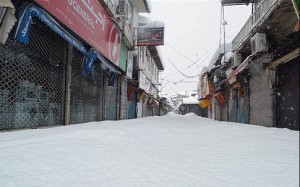February 07-2014

A huge winter storm has descended upon much of Iran, leaving about half of the country in the grip of freezing cold and the region between Tehran and the Caspian under mounds of snow,
The city of Tonakabon, which lies on the Caspian coast 140 kilometers (90 miles) northwest of Tehran, was digging out from under more than 20 inches of the white stuff. Towns on the northern slopes of the Alborz mountains got even more—with some reports of two-meter depths.
Troops from the Army and Pasdaran were dispatched to help dig people out.
The worst hit provinces were Gilan and Mazandaran, which lie between the Caspian and the Alborz range. Meteorologists said that area was facing the worst winter storm in five decades. The last big storm in the area was 10 years ago in 2004.
The Chalus deputy told the Majlis that 145 towns and 10 cities in his constituency were isolated and cut off by the deep snow.
With prevailing winds from the northwest, clouds are pushed up against the Alborz, which brings substantial rain in the growing season and makes the area very productive. But in winter, that heavy rain becomes crippling snow.
Four people were reported to have died around Tonakabon when they could not be taken to the city hospital from surrounding villages. Three of them had been due for regular kidney dialysis treatment.

Tehran got snow Monday night, but it was only deep in the northern areas. Elementary schools were closed Tuesday throughout the city. High schools were closed only in Districts 1 through 5, which cover the northern third of the city where the wealthy are primarily concentrated.
The capital’s snow management office said it had a challenge clearing city streets because some of its staff and equipment had been sent over the mountains to help out in Mazandaran.
Over the weekend, officials said cold and snow cut off power and natural gas to more than 480,000 homes, which means about 2 million people, in Gilan and Mazandaran. On Tuesday, the Interior Ministry said power was restored to 95 percent of the homes that had been cut off, but there was considerable suspicion about the accuracy of that figure.
In such weather, many villages, especially in the mountains, are simply unreachable and the extent of the damage done to them often isn’t known until the storm abates enough for someone to get out.
There was a drop in gas supply pressure in some cities, the Energy Ministry announced Monday. Natural gas is the chief heating fuel in most of the country’s urban areas.
Soaring demand for gas for heating meant the gas company slashed supplies of gas to petrochemical plants on the Persian Gulf coast, forcing operators there to fall back on their fuel in storage, the Shana news service said.
“Petrochemical plants have stored enough products so the market is faced with no problem,” Abbas Sheri Moqqadam, head of the state-run National Petrochemical Company, told Shana.
Iran has huge gas reserves but the expansion of production has been curtailed as a result of sanctions so that supplies are insufficient to meet demand in the winter months. The first thing that is always done to maximize supplies for home heating is to stop gas supplies to electrical generating plants that then shift to oil for fuel. With Iran under sanctions, there is no shortage of oil!
Northeastern Iran relies heavily on gas imports from next-door Turkmenistan, especially for heating in winter.
The head of Tehran’s Department of the Environment has warned of cold weather and icy conditions presenting problems at animal sanctuaries in the capital.
Hamid Rahati has warned that the sudden drop in temperature this week will demand special care at zoos and at animal and bird sanctuaries.
The warning from Tehran’s Department of the Environ-ment comes after earlier cold and icy conditions led to the loss of many birds at the Shiraz zoo.
